Rab11 supports amphetamine-stimulated norepinephrine transporter trafficking
- PMID: 20534835
- PMCID: PMC2935280
- DOI: 10.1523/JNEUROSCI.4574-09.2010
Rab11 supports amphetamine-stimulated norepinephrine transporter trafficking
Abstract
The norepinephrine transporter (NET) is a presynaptic plasma membrane protein that mediates reuptake of synaptically released norepinephrine. NET is also a major target for medications used for the treatment of depression, attention deficit/hyperactivity disorder, narcolepsy, and obesity. NET is regulated by numerous mechanisms, including catalytic activation and membrane trafficking. Amphetamine (AMPH), a psychostimulant and NET substrate, has also been shown to induce NET trafficking. However, neither the molecular basis nor the nature of the relevant membrane compartments of AMPH-modulated NET trafficking has been defined. Indeed, direct visualization of drug-modulated NET trafficking in neurons has yet to be demonstrated. In this study, we used a recently developed NET antibody and the presence of large presynaptic boutons in sympathetic neurons to examine basal and AMPH-modulated NET trafficking. Specifically, we establish a role for Rab11 in AMPH-induced NET trafficking. First, we found that, in cortical slices, AMPH induces a reduction in surface NET. Next, we observed AMPH-induced accumulation and colocalization of NET with Rab11a and Rab4 in presynaptic boutons of cultured neurons. Using tagged proteins, we demonstrated that NET and a truncated Rab11 effector (FIP2DeltaC2) do not redistribute in synchrony, whereas NET and wild-type Rab11a do. Analysis of various Rab11a/b mutants further demonstrates that Rab11 regulates NET trafficking. Expression of the truncated Rab11a effector (FIP2DeltaC2) attenuates endogenous Rab11 function and prevented AMPH-induced NET internalization as does GDP-locked Rab4 S22N. Our data demonstrate that AMPH leads to an increase of NET in endosomes of single boutons and varicosities in a Rab11-dependent manner.
Figures
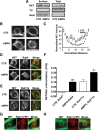

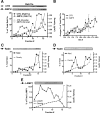
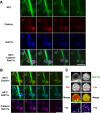

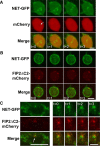
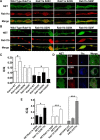

Similar articles
-
Differential Internalization Rates and Postendocytic Sorting of the Norepinephrine and Dopamine Transporters Are Controlled by Structural Elements in the N Termini.J Biol Chem. 2016 Mar 11;291(11):5634-5651. doi: 10.1074/jbc.M115.702050. Epub 2016 Jan 19. J Biol Chem. 2016. PMID: 26786096 Free PMC article.
-
Rab11, but not Rab4, facilitates cyclic AMP- and tauroursodeoxycholate-induced MRP2 translocation to the plasma membrane.Am J Physiol Gastrointest Liver Physiol. 2014 Oct 15;307(8):G863-70. doi: 10.1152/ajpgi.00457.2013. Epub 2014 Sep 4. Am J Physiol Gastrointest Liver Physiol. 2014. PMID: 25190474 Free PMC article.
-
Involvement of threonine 258 and serine 259 motif in amphetamine-induced norepinephrine transporter endocytosis.J Neurochem. 2010 Oct;115(1):23-35. doi: 10.1111/j.1471-4159.2010.06898.x. Epub 2010 Jul 30. J Neurochem. 2010. PMID: 20626559 Free PMC article.
-
A closer look at amphetamine-induced reverse transport and trafficking of the dopamine and norepinephrine transporters.Mol Neurobiol. 2009 Apr;39(2):73-80. doi: 10.1007/s12035-009-8053-4. Epub 2009 Feb 6. Mol Neurobiol. 2009. PMID: 19199083 Free PMC article. Review.
-
Mechanisms of amphetamine action revealed in mice lacking the dopamine transporter.J Neurosci. 1998 Mar 15;18(6):1979-86. doi: 10.1523/JNEUROSCI.18-06-01979.1998. J Neurosci. 1998. PMID: 9482784 Free PMC article. Review.
Cited by
-
Role of Phosphorylation of Serotonin and Norepinephrine Transporters in Animal Behavior: Relevance to Neuropsychiatric Disorders.Int J Mol Sci. 2025 Aug 9;26(16):7713. doi: 10.3390/ijms26167713. Int J Mol Sci. 2025. PMID: 40869034 Free PMC article. Review.
-
Regulation of monoamine transporters: Role of transporter phosphorylation.Pharmacol Ther. 2011 Feb;129(2):220-38. doi: 10.1016/j.pharmthera.2010.09.009. Epub 2010 Oct 15. Pharmacol Ther. 2011. PMID: 20951731 Free PMC article. Review.
-
Norepinephrine transporter defects lead to sympathetic hyperactivity in Familial Dysautonomia models.Nat Commun. 2022 Nov 17;13(1):7032. doi: 10.1038/s41467-022-34811-7. Nat Commun. 2022. PMID: 36396637 Free PMC article.
-
Insulin reveals Akt signaling as a novel regulator of norepinephrine transporter trafficking and norepinephrine homeostasis.J Neurosci. 2010 Aug 25;30(34):11305-16. doi: 10.1523/JNEUROSCI.0126-10.2010. J Neurosci. 2010. PMID: 20739551 Free PMC article.
-
Interference of norepinephrine transporter trafficking motif attenuates amphetamine-induced locomotor hyperactivity and conditioned place preference.Neuropharmacology. 2018 Jan;128:132-141. doi: 10.1016/j.neuropharm.2017.10.005. Epub 2017 Oct 4. Neuropharmacology. 2018. PMID: 28986281 Free PMC article.
References
-
- Ahmed BA, Jeffus BC, Bukhari SI, Harney JT, Unal R, Lupashin VV, van der Sluijs P, Kilic F. Serotonin transamidates Rab4 and facilitates its binding to the C terminus of serotonin transporter. J Biol Chem. 2008;283:9388–9398. - PubMed
-
- Apparsundaram S, Galli A, DeFelice LJ, Hartzell HC, Blakely RD. Acute regulation of norepinephrine transport: I. Protein kinase C-linked muscarinic receptors influence transport capacity and transporter density in SK-N-SH cells. J Pharmacol Exp Ther. 1998a;287:733–743. - PubMed
-
- Apparsundaram S, Schroeter S, Giovanetti E, Blakely RD. Acute regulation of norepinephrine transport: II. PKC-modulated surface expression of human norepinephrine transporter proteins. J Pharmacol Exp Ther. 1998b;287:744–751. - PubMed
-
- Becker KP, Hannun YA. cPKC-dependent sequestration of membrane-recycling components in a subset of recycling endosomes. J Biol Chem. 2003;278:52747–52754. - PubMed
Publication types
MeSH terms
Substances
Grants and funding
LinkOut - more resources
Full Text Sources
Molecular Biology Databases
